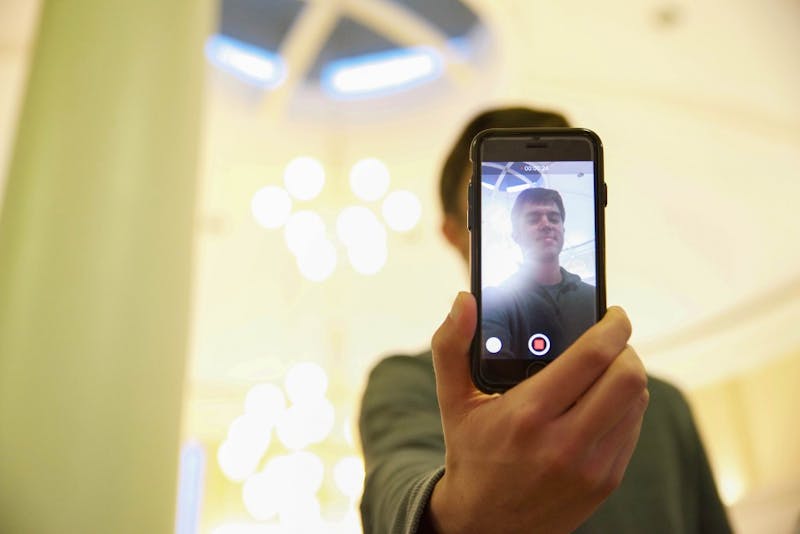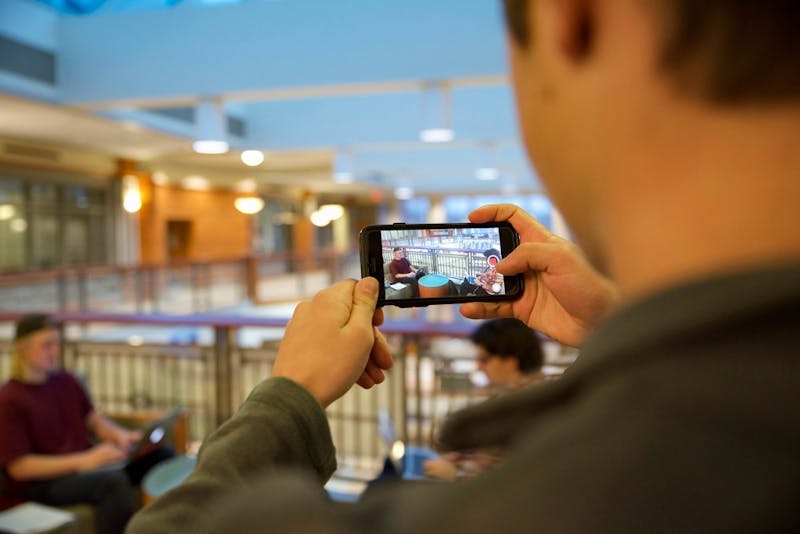
GIF from YouTube users CaseyNeistat, Apple and Alex Marchionda


GIF from YouTube users CaseyNeistat, Apple and Alex Marchionda
01.18.2016
When Lindokuhle Mnyandu traveled across the Atlantic Ocean to shoot a narrative film in Maputo, Mozambique, he decided to leave his conventional filming rigs at home and take a pocket-size device.
“I didn't want to carry traditional shooting gear across the Atlantic, so I thought, ‘Why not use a mobile device?’ ” Mnyandu, who is currently in South Africa, said in an email. “I find (a) traditional shooting rig to be bulky and a bit intimidating to new actors, whereas a mobile phone is something that they also have in their pockets and is easier to relate to.”
Mnyandu, who graduated from Ohio University with a master’s of fine arts in 2013, used a Samsung Galaxy S2 to capture images and a Nokia XpressMusic phone to record sound.
The affordability, convenience and prominence of cellphones allow filmmakers and videographers with a low budget to create films and videos with near-professional results.
In 2015, Tangerine, an independent film shot almost entirely on an iPhone 5s, was the first of its kind to be shown in Park City, Utah at the Sundance Film Festival. Sundance, the “United States’ most important film festival,” according to IndieWire, aims to support filmmakers with a low budget.
Sean Baker, the director of Tangerine, decided to use cellphones to capture the story he wanted to tell, according to The Verge. He used three phones, attachable lenses and a $10 film app called Filmic Pro, which allowed more control over the cellular device.
Baker spent comparatively little to make Tangerine, a departure from the “capital intensive” process of making films before the age of cellphones, Thomas Hayes, an assistant professor of film, said. With new technology, the cost barrier for video storytelling is lower than ever.
The cost of a Canon XA20 Camcorder, which is “ideal for shooting professional content at almost any level,” according to Epfilms, a website that reviews filming equipment, is $2,000 on Amazon. A new iPhone 7 Plus has a price of $769, according to Apple, but many people can use the phones they already have in their pockets.
“I think not that it’s just convenient, but I think it’s changing the geography of media in the United States and around the world,” Hayes said. “(Filmmakers) don’t have to dump thousands (of dollars) on cameras and sound equipment — they can just bear witness to the events in their lives and then share them around the planet. I think it’s just massively a revolution.”
Rebecca Sell, an associate professor in the School of Visual Communication, said cellphones are “less intimidating” and allow anybody who has a cellphone to become a storyteller. Using cellphones alleviates cost restraints as well, and it suppresses the need to have the biggest and best cameras.
“There are pluses to having those really high-end cameras, but it takes down that barrier of entry into being a storyteller because everybody has a cellphone,” Sell said.

Blake Nissen
Sophomore Alex Marchionda studying intergrated media makes videos on his iPhone. These videos were his inspiration to enter the program.
Alex Marchionda, a sophomore studying integrated media, likes the accessibility of the cellphone and the “ability to use (his) iPhone everywhere,” he said. Marchionda uses his iPhone 6s to make videos for his YouTube channel, which consists of parody videos. His most-viewed upload is a parody of Macklemore and Ryan Lewis’ “Downtown.” The video, titled “Smalltown,” has more than 30,000 views.
During Winter Break, he said he shot in a restaurant using his cellphone, a public location where it would be have been difficult to use a bigger camera. Marchionda does not see much of a difference between cellphone and professional-grade camera imagery, he said.
Mnyandu said he liked the freedom of being able to shoot anywhere — which included busy markets — and anytime. Shooting on a cellphone, he said, allowed him to film in populated places without drawing a large crowd of people.
“I wanted the background to be natural and the extras to be real people going about their daily lives. This is easier to pull off with a barely noticeable mobile device,” Mnyandu said in an email. “Plus, I wanted to test this modern media technology and see what it can do for any type of storyteller or filmmaker (who) may not have much to work with. I wanted to see how flexible the tools could be.”
Even though cellphones are easily accessible and affordable for most people, some difficulties with sound and image quality can arise when filming on the devices.
“They’re not great cameras. You don’t have a lot of control over the focal length and depth of field,” Hayes said. “I think that (cellphones) have a niche … but I don’t think that the next Lord of the Rings trilogy is going to be shot on a cellphone camera.”
Todd Fredricks, an assistant professor of family medicine in the Heritage College of Osteopathic Medicine, is in the process of filming medical documentaries and often uses an iPhone 6s for his projects. The first documentary he and his team will be releasing later this year is about soldiers who are injured or contract illnesses while in the line of duty and how they transition back home.
Though Fredricks likes the image quality of a cellphone, the sound is not at the same standard. To combat the poor sound quality of a cellphone, he uses a handheld sound recorder — a Zoom H4N, with a price of $200.
“If you have a good story, you can allow for a lot of sins in production,” he said. “That said, if you’re going to prioritize, you’re always going to want the best sound you can get followed by video … but the story is supreme.”

Blake Nissen
Sophomore Alex Marchionda studying Intergrated Media makes videos on his iPhone. These videos were his insperation to enter the program
Keeping the cellphone steady while filming can also be a difficult feat, Marchionda said. When filming on his phone, Marchionda will try to keep himself and the device as steady as possible. If the video is still shaky, he uses a stabilizing feature during the editing process, which is mostly done in iMovie, an app that is free for Macbook users and $4.99 for those with iPhones and iPads. Tripods are available for cellphones, and they can be bought for about $14 on Amazon to help stabilize the device.
“(The aspect) that bugs me the most is the shakiness,” he said. “With my camera, I’ll have a tripod, and it’s just steady shots. The thing you can kind of tell with iPhones is it will be shaky because someone is holding it.”
Mnyandu was not able to adjust his focus and exposure on the cellphone, which resulted in images that were not as sharp or bright as he would have liked, he said. Different detachable lenses can be purchased to help with zoom and focus on cellphones. Despite not being able to control some of the setting on his phone, Mnyandu said he would not have done anything differently, as he gained more than he lost during the filming process.
“Without the cumbersome technicalities that sometimes come with all of the equipment, I felt closer to the narrative,” he said in an email. “I found myself closer to (the) essence of why I make movies, which is to follow the storytelling tradition.”